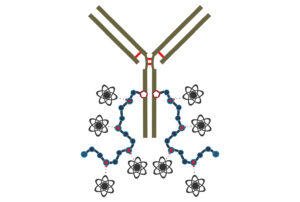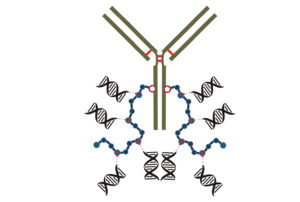ONCOLOGY
New therapeutic windows and early tumor detection
ANTIBODY-RADIONUCLIDE CONJUGATE TARGETING L1CAM
Despite the advancements in therapies, cancer remains a significant health burden. Over 10 million cancer patients die every year. Especially aggressive forms of cancer with poor prognosis and high spread of metastasis remain an important challenge. CIS Pharma develops an antibody-radionuclide conjugate, ARC, a targeted treatment for cancer patients resistant to chemotherapy.
The antibody targets L1CAM (CD 171), a surface protein that is overexpressed in ovarian, colorectal, lung and many other types of cancer. The L1CAM surface protein was identified to be overexpressed in cancer-cells with high spread of metastasis and fast disease progression.
The therapeutic radionuclide Lutetium-177 is conjugated to the L1CAM antibody. Also, novel radionuclides are developed that exhibit greater potential in killing cancer cells compared to standard of care.
CIS Pharma’s payload technology enables the conjugation of radionuclides and/or cytotoxic payloads to the antibody. In-vivo data indicates a positive effect of the polymer carrier on conjugation of radionuclides to the antibody and on pharmacokinetics of the delivered radionuclide therapy. The polymer-based payload technology also serves as a dual-active carrier to conjugate compounds that exhibit synergies in killing cancer-cells, such as radionuclides and radiosensitizers.

NANOBODY-RADIONUCLIDE CONJUGATE
Due to its fast and deadly nature, brain cancer glioblastoma, GBM, comprises a poor prognosis. Treatment options are limited, and recurrence is universal. The blood-brain barrier, BBB, excludes the vast majority of cancer therapeutics from the brain. Clinical evidence demonstrates that there is a clinically significant tumor burden with an intact BBB in all GBM.
A novel target was found to play an important role in GBM. CIS Pharma develops a nanobody to target the respective surface protein. Nanobodies are smaller in size, 10% of a full antibody, and allow deeper penetration of solid tumors with faster accumulation in the target tissue.
The target plays a role in the adaptive immune system and is a potential checkpoint inhibitor ligand. It is overexpressed in differentiated malignant cells and promotes migration, invasion, angiogenesis and chemoresistance of tumor cells.
Based on CIS Pharma’s payload technology, the nanobody is designed to carry one or more different types of diagnostic or therapeutic radionuclides that are conjugated to a single nanobody.

POLYMER CARRIER TECHNOLOGY TO DELIVER RNAi THERAPEUTICS
RNA interference (RNAi) is a mechanism used to defend against external invasion. Oligo- and poly-nucleotide based RNAi therapeutics comprise a high clinical potential for unmet medical diseases and are seen as promising approach to combat a number of different indications including oncology, genetic disorders, auto-immune disorders, orphan diseases and viral infections.
Without a targeting technology, the therapeutics are predominantly metabolized by the liver. To prevent metabolization, the oligo-nucleotides are applied locally, limiting the clinical window for oligonucleotide therapies. Alternatively, targeted delivery to specific cells has to be developed to create novel therapies.
To widen the therapeutic use of oligonucleotides, CIS Pharma is developing a technology for bio-conjugation of RNAi to targeting moieties, similar to the targeting technology developed for cancer therapies. The technology is developed to conjugate both single-stranded antisense oligonucleotides, ASO, as well as double-stranded short interfering RNA, siRNA.
CIS Pharma’s polymer-based delivery system is expected to protect the therapeutic RNA from degradation, to increase circulation time. The carrier is conjugated to targeting moieties.
